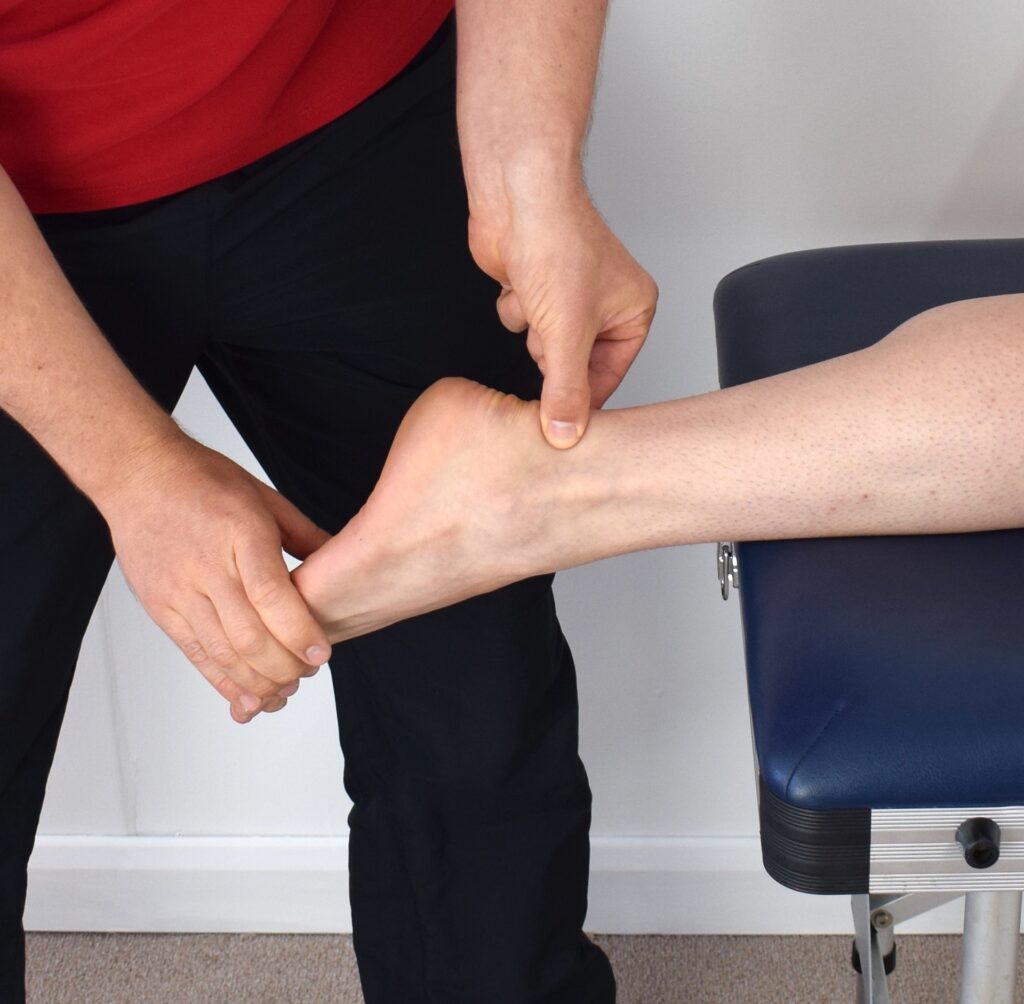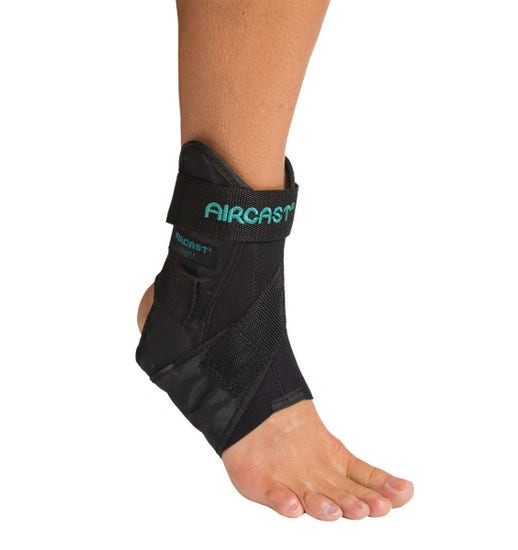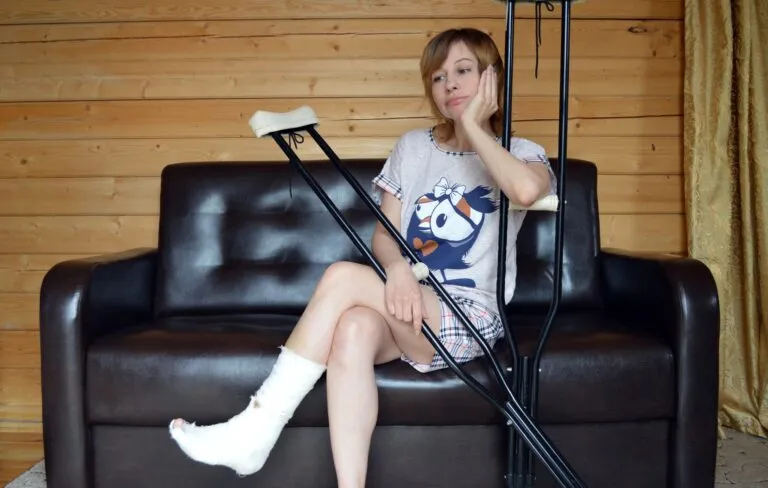Ankle Sprains: The Basics
Ankle sprains are one of the most common sport injuries and account for the majority of ankle injuries.8
They can be caused by: walking or exercising on an uneven surface, falling, landing on your ankle, rolling or twisting your foot, or getting stepped on causing the foot to twist or roll.
Pain and instability often follow acutely (weeks) after an ankle sprain with up to 70% of people reporting persistent residual symptoms and injury recurrence, and up to 40% going on to develop chronic instability (>1 year after injury).7,15
Posttraumatic osteoarthritis (PTOA) can occur in cases where damage to the cartilage happens with the injury with 13-21.7% of PTOA having a history of ankle sprain.9
Both non-operative and operative treatments are available depending on the type and amount of injury.
Anatomy of the ankle
The lower leg bones connect to the foot through the ankle joint. It is comprised of three bones, the two lower leg bones (tibia and fibula), and the ankle bone (talus). It is stabilized on the outside by ligaments and muscles. Ankle ligaments are strong, slightly elastic bands of connective tissue that connect between the different bones in the ankle.

There are 3 main ligaments on the outside of the ankle, with the anterior talofibular ligament (ATFL) being the most commonly injured with a lateral ankle sprain, followed by the calcaneofibular (CFL), and posterior talofibular ligament (PTFL).12
The fan-shaped deltoid ligament is injured in medial ankle sprains.

Additional stability is provided by the anterior inferior tibiofibular ligament (AITFL) and posterior inferior tibiofibular ligament (PITFL), connective tissue between the tibia and fibula which are injured in a high ankle sprain.
Types of ankle sprains
There are three main types of ankle sprains: lateral ankle sprains, medial ankle sprains, and high ankle sprains.
Lateral ankle sprains are the most common, making up ~80% of injuries, followed by medial and high ankle sprains.6 Lateral ankle sprains typically occur with an inversion injury. This often involves the foot rolling in and under the ankle, which can stretch or tear the ligaments on the outside of the ankle.

Medial ankle sprains typically occur with an eversion injury. This involves the foot rolling out and away from the ankle, which can stretch or tear the large fan-like ligament on the inside of the ankle.
High ankle sprains usually involve an external rotation force and separates the two bones in the leg (tibia and fibula).
Symptoms
Symptoms following ankle sprain typically include:
- pain – most common when placing weight on the foot and ankle
- swelling & bruising – can affect the ankle, foot and sometimes the lower leg
- tenderness – felt over the injured ligaments
- feelings of instability in the ankle joint
Diagnosis
In order to diagnose an ankle sprain, your doctor or physiotherapist will assess your movements and symptoms and may want to rule out a fracture.

This will involve feeling the bones in your ankle and foot for alignment as well as any tenderness, checking your ankle movements, comparing the amount of swelling and bruising to your other ankle, and sending you for x-rays if needed to rule out a fracture.
Ultrasound and MRI may occasionally be used to assess an ankle sprain.11
Ankle Sprain Grades
I – Mild. Ligament stretch
II – Moderate. Partial ligament tear
III – Severe. Full ligament tear
Most ankle sprains can be diagnosed from physical examination which can often show joint laxity (looseness) of the ankle, and is best appreciated 4-5 days after initial injury.11,15
Your doctor may feel each ligament to see if it causes pain, as well as stressing the ankle joint to see if there is any laxity in the joint.
Treatment
RICE (Rest, Ice , Compression, Elevation) can be used for the first 2-3 days after an ankle sprain.1
NSAIDs such as Advil, Motrin, Aleve, etc. can be used to help decrease pain and swelling, but should only be taken in the first 2 weeks as they can delay the natural healing process.13,15
Ankle sprains are typically treated by physiotherapists or athletic therapists. Initially a phase of rest and immobilization may be used, but should only be used in cases of severe, grade III sprains, for a maximum of 10 days.11,15
Alternatively, an ankle brace can be used for up to 6 weeks, and is more effective than a tensor or elastic bandage.7,15

Exercise therapy should start as soon as possible after the initial sprain to prevent recurrent sprains and it should consist of range of motion, flexibility, strengthening, and balance training to help restore strength and proprioception to the joint.7,11,15
Return to sport and work should be done at an individual level when you feel comfortable returning and not re-injuring the ankle.
Because ankle sprains are so common, they often have insufficient rehab because people do not seek treatment advice from medical professionals. It is suggested to see a physiotherapist to aid with rehab, to prevent chronic ankle instability.
Operative management of acute ankle sprains is not recommended, but can be considered on an individual basis.1,5
Functional outcomes between conservative and operative management are similar, but operative management carries more risk of complications.15
Chronic ankle instability that has not responded to physiotherapy and rehabilitation may be an indication for operative management.15 However, external ankle supports such as bracing has been shown to decrease the risk of recurrent ankle sprain.10 Surgery usually involves reconstruction or repair of the ligaments on the outside of your ankle; however, there is no best type of surgery in terms of outcomes.3
Additionally, ankle sprains may put you at higher risk for PTOA of the ankle, which may necessitate surgery such as an ankle fusion or joint replacement if pain and symptoms becomes severe. Patients with a history of lateral ankle sprains make up 13-22% of all ankle osteoarthritis cases and 70-85% of surgical cases for end-stage ankle joint PTOA.14 Research has shown that 13% of patients with chronic instability have evidence of arthritis on X-ray by 20 years.4
Prevention
The biggest predictor of a future ankle sprain is a previous ankle sprain.2
For this reason, prevention of future injuries by completing a rehab program of range of motion, strengthening, balance, and agility is very important.
Research has shown a number of ways to prevent future ankle sprains.
Ankle bracing and taping has been shown to be effective in preventing ankle sprains.7,10,15 The exact mechanism that they help is not completely understood at this time, but may involve mechanical stability of the joint and prevent the ankle from rolling, but may also provide increased proprioceptive feedback.
Good rehabilitation following an ankle sprain is important in preventing a future ankle sprain. A good rehab program can be found here: https://myhealth.alberta.ca/Health/Pages/conditions.aspx?hwid=te7604.
Contributing Expert

Brandon Zhao, MD Candidate, Faculty of Medicine & Dentistry, University of Alberta
References
- Al-Mohrej OA, Al-Kenani NS. Acute ankle sprain: conservative or surgical approach?. EFORT Open Rev. 2017;1(2):34-44.
- Beynnon BD, Murphy DF, Alosa DM. Predictive Factors for Lateral Ankle Sprains: A Literature Review. J Athl Train. 2002;37(4):376-380.
- Cao Y, Hong Y, Xu Y, Zhu Y, Xu X. Surgical management of chronic lateral ankle instability: a meta-analysis. J Orthop Surg Res. 2018;13(1):159.
- Carbone A, Rodeo S. Review of current understanding of post-traumatic osteoarthritis resulting from sports injuries. J Orthop Res. 2017;35(3):397-405.
- Chaudhry H, Simunovic N, Petrisor B. Cochrane in CORR ®: surgical versus conservative treatment for acute injuries of the lateral ligament complex of the ankle in adults (review). Clin Orthop Relat Res. 2015;473(1):17-22.
- Doherty C, Delahunt E, Caulfield B, Hertel J, Ryan J, Bleakley C. The incidence and prevalence of ankle sprain injury: a systematic review and meta-analysis of prospective epidemiological studies. Sports Med. 2014;44(1):123-140.
- Doherty C, Bleakley C, Delahunt E, Holden S. Treatment and prevention of acute and recurrent ankle sprain: an overview of systematic reviews with meta-analysis. Br J Sports Med. 2017;51(2):113-125.
- Fong DT, Hong Y, Chan LK, Yung PS, Chan KM. A systematic review on ankle injury and ankle sprain in sports. Sports Med. 2007;37(1):73-94.
- Gribble PA, Bleakley CM, Caulfield BM, et al. Evidence review for the 2016 International Ankle Consortium consensus statement on the prevalence, impact and long-term consequences of lateral ankle sprains. Br J Sports Med. 2016;50(24):1496-1505.
- Handoll HH, Rowe BH, Quinn KM, de Bie R. Interventions for preventing ankle ligament injuries. Cochrane Database Syst Rev. 2001;(3):CD000018.
- Kaminski TW, Hertel J, Amendola N, et al. National Athletic Trainers’ Association position statement: conservative management and prevention of ankle sprains in athletes. J Athl Train. 2013;48(4):528-545.
- Kobayashi T, Gamada K. Lateral Ankle Sprain and Chronic Ankle Instability: A Critical Review. Foot Ankle Spec. 2014;7(4):298-326.
- Lin CW, Hiller CE, de Bie RA. Evidence-based treatment for ankle injuries: a clinical perspective. J Man Manip Ther. 2010;18(1):22-28.
- Valderrabano V, Hintermann B, Horisberger M, Fung TS. Ligamentous posttraumatic ankle osteoarthritis. Am J Sports Med. 2006;34(4):612-620.
- Vuurberg G, Hoorntje A, Wink LM, et al. Diagnosis, treatment and prevention of ankle sprains: update of an evidence-based clinical guideline. Br J Sports Med. 2018;52(15):956.







